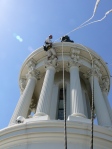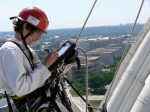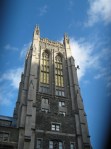
Mike Gilbert investigating the curtain wall of the Gonda Building
At the end of June and early July, Vertical Access technicians Mike Gilbert and Evan Kopelson were in Rochester, MN working with Minneapolis-based
Buildings Consulting Group, Inc. on the facade inspection of the Gonda Building. The Leslie and Susan Gonda Building, constructed in 2000 and 2001, is situated at the center of the Mayo Clinic campus in downtown Rochester. Viewed from the exterior, the building consists of two distinct sections, each 21 stories tall. The northern section has a curtain wall system with granite spandrel and column panels. Stainless steel covers with round and square profiles are used to cover the joints between panels and at the window surrounds. A stone-clad elevator bank rises to 22 stories on the north side of the building. There is also a seven-story skyway that connects the north side of the building to another Mayo Clinic building across the street. The southern portion of the building, which has only east and west façades, has an undulating curtain wall system consisting entirely of glass panels. Painted aluminum covers with a round profile are used at the vertical joints of the glass curtain wall and painted aluminum covers with a square profile are used at the horizontal joints. The design team for the original construction was led by Ellerbe Becket and included Cesar Pelli & Associates. Centex Rodgers Construction was the general contractor for the project.

Evan Kopelson documenting conditions at the skyway of the Gonda Building
The primary focus of VA’s partial façade investigation was to identify any conditions of immediate safety concern and document conditions of deterioration for planning of maintenance and capital planning projects. A total of 32 inspection “drops” were performed, including the two swing stage drops, allowing hands-on access to cover approximately 50% of each façade. The drop locations included areas on all façades of the building, including the skyway that connecting the Gonda Building to the Charlton Building across the street. As part of the partial façade investigation, the location, severity and quantity of conditions such as loose curtain wall cover pieces, failed gaskets at the covers and windows and cracks and spalls in the stone panels were recorded on elevation drawings using Vertical Access’ Tablet PC Annotation System (TPAS). Deliverables for the project included a condition survey report with photographs, annotated AutoCAD drawings and a spreadsheet of condition quantities. The Mayo Clinic, in commissioning the hands-on investigation of their building that was just 10 years old, demonstrated a proactive approach to facility management.
Read about Project 1: Union Theological Seminary Brown Tower
Read about Project 2: University of Buffalo Alumni Arena
Read about Project 3: United States Capitol Dome
Read about Project 4: Boston College Burns Library Tower












